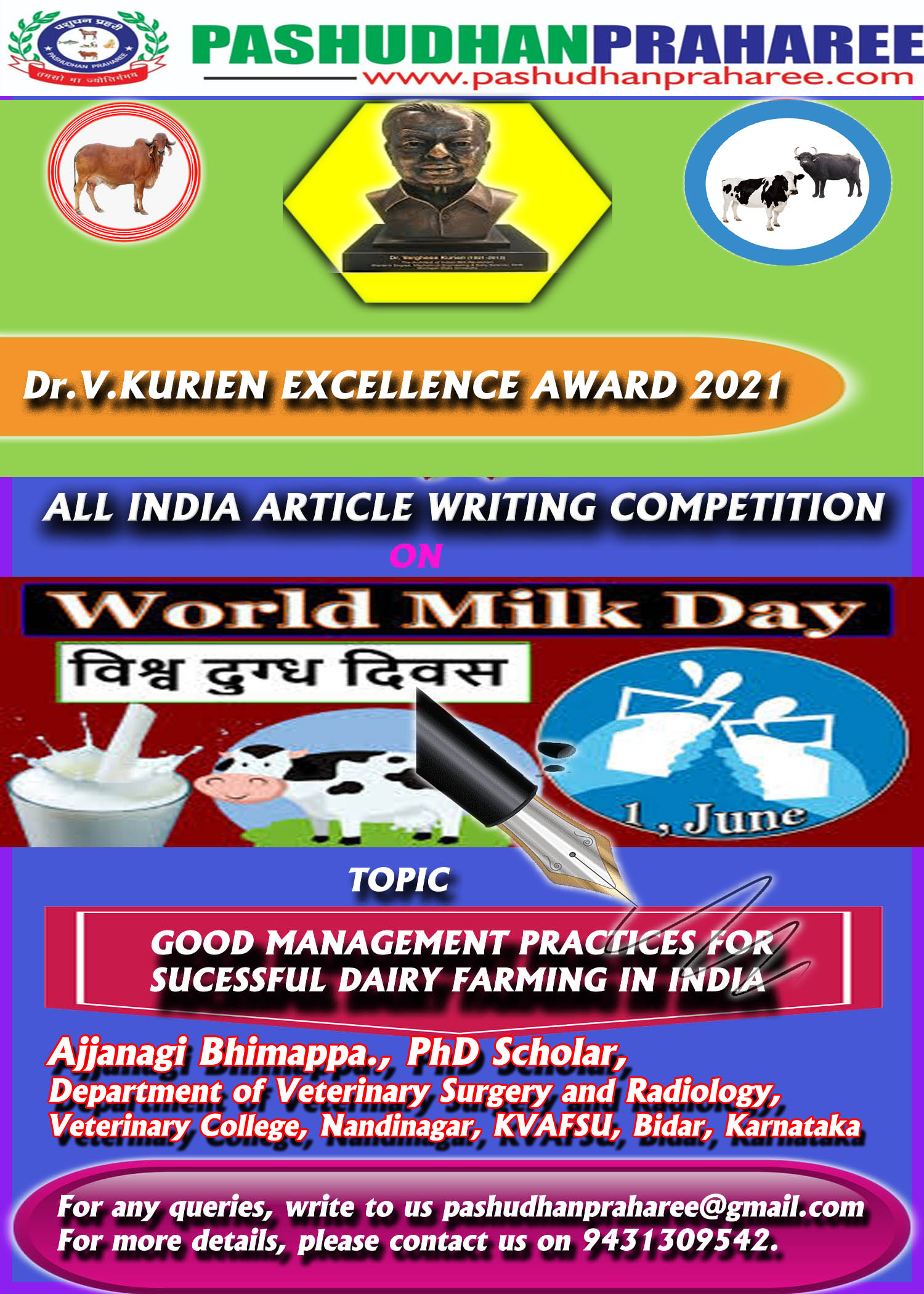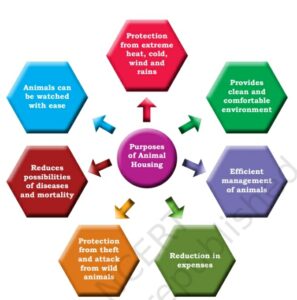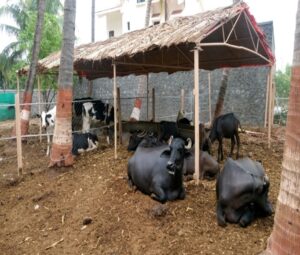GOOD MANAGEMENT PRACTICES FOR SUCCESSFUL DAIRYING IN INDIA
Introduction
Dairy farming has been an important part of the agricultural scenario for thousands of years. India being a predominantly agrarian economy has about 70 per cent of its population living in villages, where livestock play a crucial role in the socio-economic life. Livestock provide high-quality foods such as milk, cheese, butter, ghee, etc. India is not only one of the top producers of milk in the world, but also the largest consumer of milk and milk products in the world. Due to the shortfall in supply, we have to import significant amounts of milk products to meet internal demand. Agriculture and animal husbandry have a symbiotic relationship, in which the agricultural sector provides feed and fodder for the livestock and animals provide milk, manure and draught power for various agricultural operations. Dairy sector is instrumental in bringing socio-economic transformation in India. It has created a lot of employment opportunities and also provides improved nutritional benefits. Animal husbandry is a major sub-sector of agriculture sector and contributes about 28.6 per cent to the agricultural value output (Annual Report 2017–18, Department of Animal Husbandry, Dairying and Fisheries, Government of India).
General dairy farm management practices include the following routines
- Care and management of new born calf
- Fodder production and management
- Feeding /nutritional management
- Housing of animals
- Hygienic condition
- Fertility/Reproductive management
- Milking hygiene
- Animal welfare
- Health management
- Socioeconomic management
- Isolation of sick animals
- Disposal of carcases
- Weighing of animals
- Farm record maintenance
- Veterinary advise
Care and management of new born calf:
Clean nostrils and mouth which helps the calf breathe better and help to prevent future breathing problems. Allow the mother to lick the calf clean which promotes circulation within the calf’s body and prepares the calf to stand up and walk. 2 inches from the base and cut the remaining cord with a clean instrument.We must give good feeding and management for the calves so that they develop well and, useful for replacement stock. The feeding and care of the calf being before its birth .The dam should be dried 6-8 weeks before expected calving and should be fed well. Under fed animals will give weak and small calves.
Fodder production and management:
Feeding of green fodders (grass legume or cereal fodder) is always economical. In most of the farming situations, feeding concentrates or compounded feed will increase the cost of feeding which in turn raise the cost of production. If the land resource is scarce a farmer can have suitable agroforestry to increase the forage production per unit area. Almost all essential nutrients can met out from green fodder. Digestive problems of dairy animals can be solved by feeding green fodder. Some advantages of green fodder are.
- Reduced occurrence of acidocis and mastitis
- Lowered PH in rumen
- Increased digestability and longevity
- Earlier breeding and higher conception rate
- Faster weight gain and easier weaning
Feeding and nutritional management
Make sure that cows have access to clean and fresh water 24 hours per day. Cows drink 6 to 14 times per day. Usually after milking and after every meal. Preferred temperature should be between 17-27 degree celcius. Feed alone constitute 60percent of the production cost of milk. Hence, feeding management play a vital role in farm economy. The nutrient requirement should be determined for maintenance as well as for milk poduction and to meet the fat percentage in milk and gestation.
Housing of animals
In India, a great diversity exists in the design of dairy animal shelter. Traditional animal shelters have growen out of needs, resources and ingenuity of farmers. Adequate housing to animals is aimed at increased milk production, better labour utilization, better health of animals, disease control, better care and management of animals resulting in production of high quality milk resulting in a remunerative price and better profit of the farm. Main purposes of animal housing are shown in the following diagram. Various types of housing systems followed in India are, loose housing system, conventional system head to head system and tail to tail system. Among these types each systems have got their own advantages and disadvantages.
Purposes of animal housing Loose housing system
Hygienic conditions:
In all dairy operations followed in Indian conditions, small or large animal health care represents a major task to increase the production and economy. Major hygienic conditions include, routine monitoring of the farm, identification of sick animals, disinfection of the premises, sanitization, maintenance of foot bath at the entrance, supply of clean water to the animals, daily observations of calves, special care towards pregnant animals, application of ectoparaciticides to the farm and animals. Proper maintenance of all these routine works can result in successful management and increase the production of milk.
Fertility/Reproductive management:
There are a number of key areas for improving fertility/reproduction in animals. Knowing the status of dairy animals brings the animal into positive nutritive balance. Therefore mineral supplementation at a regular interval should be followed along with deworming and vaccination to enhance the reproductive performance. Synchronization programme should be followed to make ease of fertility management. In time artificial insemination, rectovaginal method is commonly used. After thoroughly cleaning the external genitalia with towel and gloves avoids the infection of reproductive tract. Hence improved reproductive performance provides many benefits such as, increased number of calves produced each year. Thus more no of animals can be produced by adopting the regular hormonal and reproductive managements.
Milking hygiene:
Milking hygiene includes pre- and post milking routines as well as the cleanliness of the equipment used to milk the cows. Pre milking procedures include, predipping, dry wiping, fore stripping and cleaning or drying of the teats and teat ends.
Animal welfare
The welfare of cows in traditional cow shelters (gaushalas), was assessed on the basis of the measurement of animal- and resource-based welfare parameters and description of the herd characteristics by the manager. A description of the condition of the cows and the resources provided to them is provided in this cross-sectional study. Small space allowance per cow, non-uniform flooring, little freedom of movement, and lack of access to pastures were the key welfare issues observed in the study. Very few cows were recorded as lame, but about half had carpal joint lesions and slightly less had lesions from interacting with shelter furniture. This study will inform the stakeholders about the concept of welfare auditing of the cow shelters, for better welfare and management of the cows in the shelters.
Animal health
This fact describes good dairy farming practice to ensure animals that produce milk are healthy and there is an effective health care programme in place. However, not all of the practices are applicable in all circumstances and may be superseded by national, international or market demands.The suggested good dairy farming practices for animal health are set out under the following headings:
- Establish the herd with resistance to disease.
- Prevent entry of disease onto the farm.
- Have an effective herd health management programme in place.
- Use all chemicals and veterinary medicines as directed.
Vaccination schedule for adult animals
| Vaccine | Months |
| Foot and mouth | January to February |
| Abortion causing brucellosis | March to April |
| Anthrax disease | April to may |
| Foot and mouth disease( twice a year) | June to July |
| Black quarter | August to September( before monsoon) |
| Hemorrhagic septicemia | September to October |
Socioeconomic management:
In India no problem is as grave and alarming as that of unemployment. Poverty and unemployment rates followed by inequalities of income and consumption have been substantial. The animal production enterprises particularly dairy provides not only additional income, but also provides much larger employment opportunities to rural population. The agriculture being only seasonal, the dairy industry provides off-season work, steady income and keeps the rural population employed throughout the year. As per the 2003 livestock census, India had 485 million livestock population and 489 million poultry population, having the second highest number of cattle (185 million), and the highest number of buffaloes (97 million) in the world. Livestock sector has been playing an important role in Indian economy and is an important sub sector of Indian agriculture. The contribution of livestock to GDP decreased from 5.22% in1999-00 to 4.36% in 2004-05 at current prices.
Isolation of sick animals
Isolation is the process of segregation of affected and in contact animals from the apparently healthy ones, in the event of outbreak of a contagious disease. Such segregated animals should preferably be housed in a separate isolation shed situated far away from the normal animal house.If a separate shed is not available the animals for isolation should be tied at one end of the shed as far away from the apparently healthy stock as possible.Attendants and equipment for sick animals should be ideally separate. If due to practical reasons this is not possible the sick animals should be attended only after the healthy stock.
Disposal of carcass
The primary purpose of safe disposal of carcass is to ensure the check and spread of disease either to other susceptible animals or humans.Carcasses of animals may be disposed of by sending them to knackeries or by burial or burning.The carcass must be buried in its skin, be covered with a sufficient quantity of quicklime or other disinfectants.The dead animals should be arranged upon its back with feet upwards.The skin is slashed inside the pit all cases except in the case of anthrax.Burning of carcass can be done by surface burning and flame gun methods.
Weighing of animals
Weighing of animals is an important operation in a dairy farm to know the growth rate of calves, to calculate the amount of feed and fodder to be offered to animals and for calculation of drug dosage of animals. Weighing of the animals can be done by two ways,
Direct method
The animals are passed through the weighing yard and weighing is carried out on the platform balances. Allow the animal to stand for a while on the platform before recording the weight.Weighments of the animals are to be done in the morning before feeding and watering to get the accurate weights. This method is followed mostly in organized farms.
Indirect method
The weight of the animal can be obtained indirectly by measuring the girth and length of the animal using a measuring tape. The length of the animal is obtained by measuring the distance between the points of shoulder to the point of pin bones. The girth of the animal can be obtained by measuring the circumference of the chest of the animal just behind the elbows. After obtaining the length and girth of the animal, the following formulae are applied to get the weight of animal.
Farm Record Maintenance
Record keeping is key operation to know the progress of dairy farm. It is maintained for the following purposes.
- To know the pedigree and history of the animals maintained.
- It helps in knowing the dairy activities carried out in the farm like deworming, Vaccination, deticking, castration, identification etc.
- It helps in identification of each animal in the herd and knowing the production performance of the animals.
- It helps in knowing the herd average, milch average, average daily milk yield, lactation number, lactation length etc.
- It aids in breed wise improvement of herd.
Veterinary Advice:
It is essential to have the advice of a veterinarian on regular basis to have a clear cut idea of dairy management. The farm managemental practices starting from the project report of the dairy farm, vaccination, deworming, isolation of sick animals and milking hygiene advices have to be followed by a Veterinarian.
Conclusion:
Dairy farming is a class of agriculture for long-term production of milk, which is processed for Dairy farms were the best way to meet demand. Therefore it is concluded that, good managemental practices like clean milk production, health management, fertility managements and socioeconomic measures play important role in a successful dairy farming in India.
Ajjanagi Bhimappa., PhD Scholar, Department of Veterinary Surgery and Radiology, Veterinary College, Nandinagar, KVAFSU, Bidar, Karnataka
REFERENCES:
EASTRIDGE, M. L. (2006). “Major advances in applied dairy cattle nutrition”. Journal of Dairy Science. 89 (4): 1311–23. doi:10.3168/jds.S0022-0302(06)72199-3. PMID 16537963.
GRASSER, L.A.; FADEL, J.G.; GARNETT, I.; DEPETERS, E.J. (1995). “Quantity and Economic Importance of Nine Selected By-products Used in California Dairy Rations”. Journal of Dairy Science. 78 (4): 962–971.
HUSSAIN, SIRAJ (2020). “India’s COVID-19 Crisis Has Placed Its Dairy Farmers at a Crossroads”. The Wire. Archived from the original on 20 August 2020. Retrieved 21 August 2020..
MENGE; MARES, S. E.; TYLER, W. J.; CASIDA, L. E. (1960). “Some Factors Affecting Age at Puberty and the First 90 Days of Lactation in Holstein Heifers”. Journal of Dairy Science. 43 (8): 1099–1107.
Milk Production in India: Milk production and per capita availability of milk in India”. National Dairy Development Board, Government of India. Archived from the original on 17 August 2020. Retrieved 28 August 2020.
“Overview of global dairy market developments in 2018” (PDF). Rome: Food and Agriculture Organization of the United Nations. March 2019. p. 8. Archived (PDF) from the original on 11 July 2019. Retrieved 24 August 2020.
PETERS, A., & BALL, P. (2004b). Reproduction in cattle. (3rd ed.). Oxford: Blackwell Publishing.
SHARMA, HARIKISHAN (17 October 2019). “Explained: Reading the livestock census”. The Indian Express. Archived from the original on 9 December 2019. Retrieved 6 September 2020.





